Recent datasets

The study focused on the impacts of catchment development on estuaries. Our previous NESP NAER study showed that for three rivers in the Gulf, nutrient addition to intertidal mudflat cores stimulated production and by inference, a reduction in nutrients,e.g. increased extraction of water, would negatively impact primary production. The current study expanded this further to examine additional estuaries in northern Australia, i.e.

This dataset summarises benthic habitat and fish surveys in West Cape York, including the West Cape York Marine Park (Commonwealth), southern Dugong Sanctuary, Angkamuthi and Kaurareg Sea Country into 2 GIS shapefiles.
(1) A point (site) shapefile showing point location of 407 habitat survey sites.
(2) A point (site) shapefile showing point location of BRUV (baited remote underwater video) deployments to survey fish at 42 sites.

This dataset summarises subtidal benthic surveys in Yanyuwa Sea Country into 3 GIS shapefiles.
(1) A point (site) shapefile describes seagrass presence/absence at 849 subtidal sites surveyed by vessel.
(2) The meadow shapefile describes attributes of 46 subtidal seagrass meadows.
(3) The interpolation shapefile describes variation in subtidal seagrass biomass across the seagrass meadows.
This dataset contains the spatial analysis workflow, data derived from the spatial analysis, and R code to identify the blue carbon restoration opportunity in three case study regions in Australia:
1) Fitzroy Basin, QLD;
2) Peel-Harvey and northern part of South West Catchments, WA; and
3) Ord River, WA.
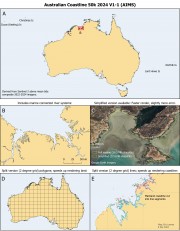
This dataset corresponds to land area polygons of Australian coastline and surrounding islands. It was generated from 10 m Sentinel 2 imagery from 2022 - 2024 using the Normalized Difference Water Index (NDWI) to distinguish land from water. It was estimated from composite imagery made up from images where the tide is above the mean sea level. The coastline approximately corresponds to the mean high water level.
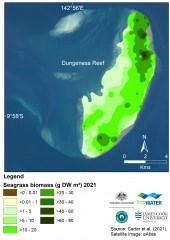
This dataset summarises intertidal benthic surveys of Dungeness Reef, Torres Strait in February 2021 into 3 GIS shapefiles. (1) The site shapefile describes (a) seagrass presence/absence and (b) species composition at 128 sites. (2) The meadow shapefile describes seagrass communities for the reef-top meadow. (3) The interpolation shapefile describes variation in seagrass biomass across sites in the meadow.

This dataset consists of one data file (spreadsheet) of outcomes from a national scale survey of practitioners and researchers working in marine and coastal ecosystem restoration. For privacy reasons the data are aggregated and presented as summary data. Long form responses have been checked to ensure that respondents are not identifiable. The survey was open for response November 8th 2021 – November 29th 2021 and had 129 valid responses.

This dataset compiles georeferenced media - including videos (480), articles (20), and datasets (6) - specifically curated to facilitate the understanding of reef habitats across northern Australia. It was designed as a research tool for virtual fieldwork with a particular focus on identifying sources of information that allow an understanding of both inshore and offshore reef environments. This dataset provides a record of the literature and media that was reviewed as part of mapping the reef boundaries from remote sensing as part of project NESP MaC 3.17.
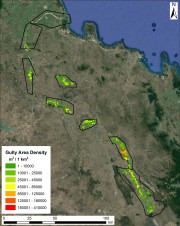
This dataset contains maps of alluvial and hillslope gullies across blocks of lidar covering portions of the Burdekin Catchment. This project is an expansion of the detailed gully mapping and assessment undertaken previously as part of NESP TWQ Project 5.10 (Daley et al., 2021), using newly available lidar as well as some older data not previously used.
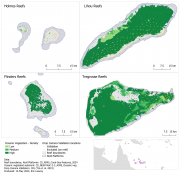
This dataset is a vector shapefile mapping the deep submerged aquatic vegetation on the bottom of the coral atoll lagoons in the Coral Sea within the Australian EEZ. This mapped vegetation predominantly corresponds to erect macroalgae, erect calcifying algae and filamentous algae (Tol, et al., 2023), with an average algae benthic cover of approximately 30 - 40%. This corresponds to only vegetation occurring on the soft sediment of the lagoons.

This code repository and dataset details a method for determining benthic reflectance from a combination of satellite imagery and bathymetry. Its key benefit is that it can map benthic reflectance up to 50 - 60 m in depth in clear waters, when using Sentinel 2 B2 channel combined with matching bathymetry data. Benthic reflectance is a measure of how much light the seafloor reflects and is useful for distinguishing areas that are sand (high reflectance) or vegetation such as seagrass, algae and coral (low reflectance).
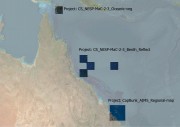
This dataset consists of collections of satellite image composites (Sentinel 2 and Landsat 8) that are created from manually curated image dates for a range of projects. These images are typically prepared for subsequent analysis or testing of analysis algorithms as part of other projects. This dataset acts as a repository of reproducible test sets of images processed from Google Earth Engine using a standardised workflow.

This project addresses the urgent need to understand and monitor the aesthetic value of the Great Barrier Reef. Focusing on the fast-changing underwater systems of the Reef, this research will use advanced technology (including eye tracking and heart rate measurement) to elicit what environmental and experiential attributes contribute to aesthetic value. A Big Data platform using artificial intelligence will be created to assess large volumes of visitor supplied imagery and to map aesthetic value across space and time.

This project will lay the foundations for the development of a reliable CoTS surveillance and control program based on detailed understanding of i) CoTS ecology, population dynamics and movement, ii) the CoTS control program’s capabilities and constraints, and, iii) IPM principles. In the project’s initial phase a COTS Integrated Pest Management (IPM) Workshop will be conducted. This workshop will bring together managers and researchers with purpose of defining a tactical approach to current COTS management and a strategic approach for the management of future outbreaks.

This project aims to provide information on cost benchmarks for key management actions to improve water quality into the GBR. The project involves a review and evaluation of summary data about NRM projects that have been funded recently to address water quality issues. By pooling the data across NRM regions and different activities, it will be possible to identify the distribution of cost/outcome ratios. From this, potential benchmarks can be established (e.g. 75% of sediment reduction actions are less than $xxx/tonne, 95% are less than $XXX per ton).

Despite the seemingly abundant opportunities, Indigenous Traditional Owners of the Great Barrier Reef appear to show little interest in participating in the lucrative coral reef tourism industry. This project seeks to understand why this is so, canvass TO attitudes to the industry, map out the opportunities for their participation in both mainstream and Indigenous-initiated ventures, and provide an assessment of current obstacles and what can be done to mitigate them.

This project will deliver two outcomes: (i) understanding of how water quality (WQ) exposure affects the ability of corals to resist and recover from bleaching, (ii) a modelling framework to identify management options that would mitigate the effects of warming on reefs exposed to WQ pressures. Using SeaSim experiments and field data, we examine which WQ parameters (nutrients/light/turbidity) affect corals’ thermal tolerance, and assess how temperature and WQ exposure histories affected coral bleaching and recovery during the 2016 bleaching event.

The Reef 2050 Long-Term Sustainability Plan and Reef 2050 Water Quality Improvement Plan 2017-2022 have set ambitious targets for Great Barrier Reef (GBR) water quality improvement. Indeed, Water Quality Improvement Plans (WQIP) for most NRMs in the Great Barrier Reef catchments recognise that complete adoption of sugar cane best management practices will still not be sufficient to achieve the nitrogen load reductions required to meet the Great Barrier Reef (GBR) Water Quality Guidelines.
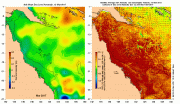
This project seeks to understand how local, regional and global oceanographic and meteorological processes influence the severity and spatial variability of thermally driven coral bleaching for the Great Barrier Reef (GBR) and Torres Strait. All available relevant environmental observations of the recent bleaching events will be gathered to be more easily discoverable to researchers and managers via a gateway/summary webpage.
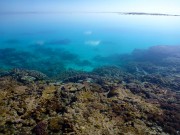
The Great Barrier Reef is experiencing increased environmental stress which threatens its functioning. Yet a subset of species are often disproportionately important in maintaining a functioning ecosystem. This project harnesses Queensland’s breadth of reef expertise to deliver timely recommendations on what can be done to strengthen and protect key supportive species. Specifically we ask which species – or functional groups of species – drive processes that maintain a healthy reef.



